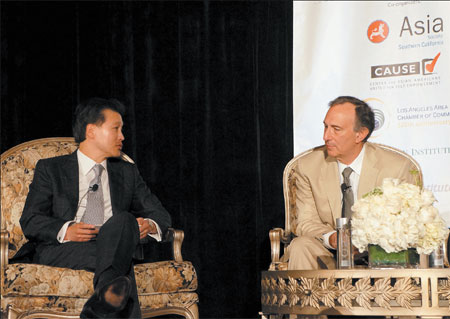US-China relations a must win
Updated: 2013-06-19 11:23
By Chen Jia in Los Angeles (China Daily)
|
||||||||
|
Dominic Ng (left), chairman of the Committee of 100 as well as chairman and CEO of East West Bank, interacts with Peter Seligmann, CEO and co-founder of Conservation International, at a panel discussion on Monday in Los Angeles. Chen Jia / China Daily |
American think tanks believe that China and the US will have tremendous opportunities for cooperation in the next 10 years, and the top three items on their work agenda should be energy, tourism, and science and technology.
"The stakes are large, for both success and failure," said Stanford economist Michael Boskin, "so the relationship needs to succeed."
Making his remarks at a panel discussion of a new study - "US-China 2022: Economic Relations in the Next 10 Years" - held by the China-US Exchange Foundation and the Committee of 100 in Los Angeles on Monday, Boskin added that the US and China's bilateral economic relationship has progressed from "virtual nonexistence to the world's most important in one generation. We have a large national interest in each other's economic success".
Dominic Ng, chairman of the Committee of 100, told China Daily at Monday's panel that the "groundbreaking study explores the dynamic evolution of US-China economic relations over the last three decades and identifies key opportunities for future bilateral cooperation", something that will benefit not just China and the US, but the whole world.
He said that frequent high-level official communications had a positive influence on the economic and cultural give-and-take between China and the US. He mentioned Chinese President Xi Jinping's two-day "shirt-sleeve" summit with US President Obama in California last week as a "golden opportunity to build a better personal rapport and mutual trust".
The study said that China was growing at almost 10 percent 30 years ago, but its impact on the global economy was small. After 20 years of this scale of growth, China has developed a $7.5 trillion dollar economy.
The growth of China and the developing world will lead to a doubling of the global economy in 10 to 15 years and probably a tripling in another 15 years, it said.
In 2010, exports of goods and services between the US and China created 730,000 jobs in the US and 11.4 million jobs in China, the study found.
Also, if current trends continue, by 2015 East Asia will surpass the US in terms of aggregate GDP, with China contributing the highest proportion of the total.
China's real GDP is projected to catch up to the US in approximately 16 years, at which time both Chinese and US real GDP will exceed $25 trillion, more than 3 times the current GDP. By 2028, China and the US will each account for about 15 percent of the world's GDP.
However, the study also projected that by 2030 Chinese real GDP per capita to be $19,960, which will still be only slightly more than a quarter of projected US per capital real GDP of $76,750.
Boskin said that China is escaping the "middle-income trap", with a large, rapidly growing middle class, which forms a large fraction of the world's growth of spending.
"If China is eventually to achieve high income - a feat very few middle-income countries manage to do - it will have to move up the value-added chain, rely much less on state direction of the economy, and decrease corruption," he said.
He pointed out that China also faces increased competition from still lower-cost countries, especially as Chinese wages grow.
Tensions over issues like cyber security, tariffs and subsidies, and currency, also go hand-in-hand with the China-US relationship, he added.
The aim of the study was "to put these frictions and misunderstanding in perspective and, particularly, to identify potential economic benefits both sides may enjoy in the next decade," said Victor K. Fung, vice chairman of the China-US Exchange Foundation.
chenjia@chinadailyusa.com
(China Daily USA 06/19/2013 page2)

 Michelle lays roses at site along Berlin Wall
Michelle lays roses at site along Berlin Wall
 Historic space lecture in Tiangong-1 commences
Historic space lecture in Tiangong-1 commences
 'Sopranos' Star James Gandolfini dead at 51
'Sopranos' Star James Gandolfini dead at 51
 UN: Number of refugees hits 18-year high
UN: Number of refugees hits 18-year high
 Slide: Jet exercises from aircraft carrier
Slide: Jet exercises from aircraft carrier
 Talks establish fishery hotline
Talks establish fishery hotline
 Foreign buyers eye Chinese drones
Foreign buyers eye Chinese drones
 UN chief hails China's peacekeepers
UN chief hails China's peacekeepers
Most Viewed
Editor's Picks

|

|

|

|

|

|
Today's Top News
Shenzhou X astronaut gives lecture today
US told to reassess duties on Chinese paper
Chinese seek greater share of satellite market
Russia rejects Obama's nuke cut proposal
US immigration bill sees Senate breakthrough
Brazilian cities revoke fare hikes
Moody's warns on China's local govt debt
Air quality in major cities drops in May
US Weekly

|

|








